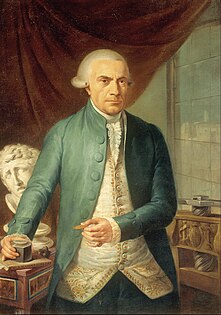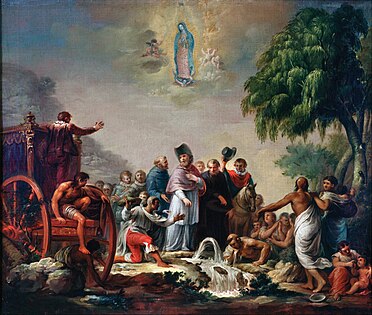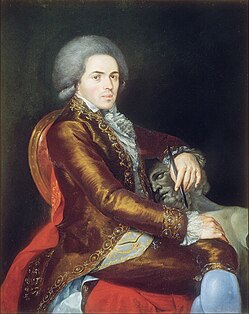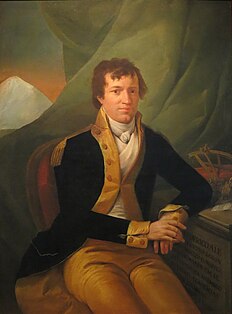Rafael Ximeno y Planes
Rafael Ximeno y Planes | |
|---|---|
| Born | 1759/60 |
| Died | 1825 |
| Education | Real Academia de Bellas Artes de San Fernando |
| Occupation | painter |
Rafael Ximeno y Planes (1759/1760–1825)[1] was a Spanish painter and draughtsman.
Biography
[edit]He was the son of a silversmith and first learned the painter's profession from his maternal uncle Luis Planes. Later he studied at the Real Academia de San Fernando in Madrid thanks to a scholarship. He also studied in Rome in 1783. In 1786 he was appointed vice-director (teniente director) of the Real Academia de San Carlos of Valencia,[2] and in 1793 he moved to Mexico City as the director of painting at the Academia de San Carlos.[3]
In addition to academic canvases, Ximeno also created the frescos in the churches of Jesús María and La Profesa, in Mexico City. His fresco ‘The Assumption of the Virgin’ can be found in the dome of Catedral Metropolitana de Ciudad de México.[2] Some of his work also appears in the Basílica de la Asunción, in the town of Cieza, Spain.
Throughout his career, he made drawings which were preparatory for prints.[2] Notable among these are his illustrations for the very popular first Spanish translation of Robinson Crusoe, by Tomás de Iriarte (1750–91), published in Madrid in 1789[4] (which is in fact a translation not of Daniel Defoe's original text, but of Joachim Heinrich Campe’s adaptation, published in Hamburg 1779–80[5]). Four of these preparatory drawings by Rafael Ximeno y Planes are preserved in the British Library. There are also drawings by José Juan Camarón y Meliá (1760–1819) for this edition of Robinson Crusoe in the British Library.[6]
More prints after drawings by Ximeno y Planes appear as illustrations in two editions of Don Quixote, one published by the Real Academia de la Lengua in Madrid (now Real Academia Española) and printed by Ibarra in 1780, and another published by Gabriel Sancha between 1797 and 1798.[7] In 1779 he illustrated an edition of Crónica de Juan II by Hernando del Pulgar.[8]
The artist is also known for the engraved portraits of Charles IV of Spain, Francisco de Quevedo and Pedro Calderón de la Barca, appearing in the series Retratos de Españoles Ilustres,[9] engraved by Mariano Brandi, for which he drew the designs.
Paintings at the Museo Nacional de Arte, Mexico City
[edit]-
Portrait of Jerónimo Antonio Gil
-
The Miracle of the Little Spring, 1809
-
Portrait of Manuel Tolsá
-
Portrait of Andrés Manuel del Río (1825)
-
Portrait of Alexander Von Humboldt
References
[edit]Constructs such as ibid., loc. cit. and idem are discouraged by Wikipedia's style guide for footnotes, as they are easily broken. Please improve this article by replacing them with named references (quick guide), or an abbreviated title. (March 2020) |
- ^ According to the biographic information in Museo del Prado’s website [3] and an academic article about the author’s work [7], his death could have taken place in 1807.
- ^ a b c ‘Ximeno y Planes, Rafael – Colección – Museo Nacional del Prado’, Museo del Prado. [accessed 10/07/2018]
- ^ A. Espinós Díaz y M. C. García Saíz, ‘Algunas obras de Rafael Ximeno y Planes anteriores a su llegada a México’, Archivo Español de Arte, 1978, CCII, pp.115–35.
- ^ B. Marizzi, ‘Robinson der Jüngere: un libro de lecciones de cosas de la Ilustración española y alemana’, Actas de los III Encuentros complutenses en torno a la Traducción, edited by M. Raders y J. Sevilla, Madrid, 1993, pp. 215–24.
- ^ J. H. Campe, Robinson der Jüngere, zur angenehmen und nützlichen Unterhaltung für Kinder, Hamburg, 1779.
- ^ B. Navarrete Prieto and Alejandro Martínez Pérez, ‘Drawings for the Spanish Robinson Crusoe by José Juan Camarón and Rafael Ximeno’, Print Quarterly, June 2018, XXXV, pp. 160–172.
- ^ E. Santiago Páez, ‘Ilustraciones para el Quijote en la Biblioteca Nacional de España’, in El Quijote. Biografía de un libro 1605–2005, Madrid, 2005, pp. 103–06.
- ^ See E. Páez Ríos, Iconografía Hispana. Catálogo de los Retratos de personajes de la Biblioteca Nacional, Madrid, 1966–70, I, nos. 2753, (7).
- ^ Ibid. nos. 1712–19
Further reading
[edit]- VV.AA., La col·lecció Raimon Casellas, exhibition catalog, Palacio Nacional de Montjuic, Publicacions del Mnac/Museo del Prado (1992) ISBN 84-87317-21-9
- Clara Isabel Senent del Caño, Rafael Ximeno y Planes. Academicismo en la Nueva España, doctoral thesis, University of Valencia, (2017)
External links
[edit]![]() Media related to Rafael Ximeno y Planes at Wikimedia Commons
Media related to Rafael Ximeno y Planes at Wikimedia Commons





